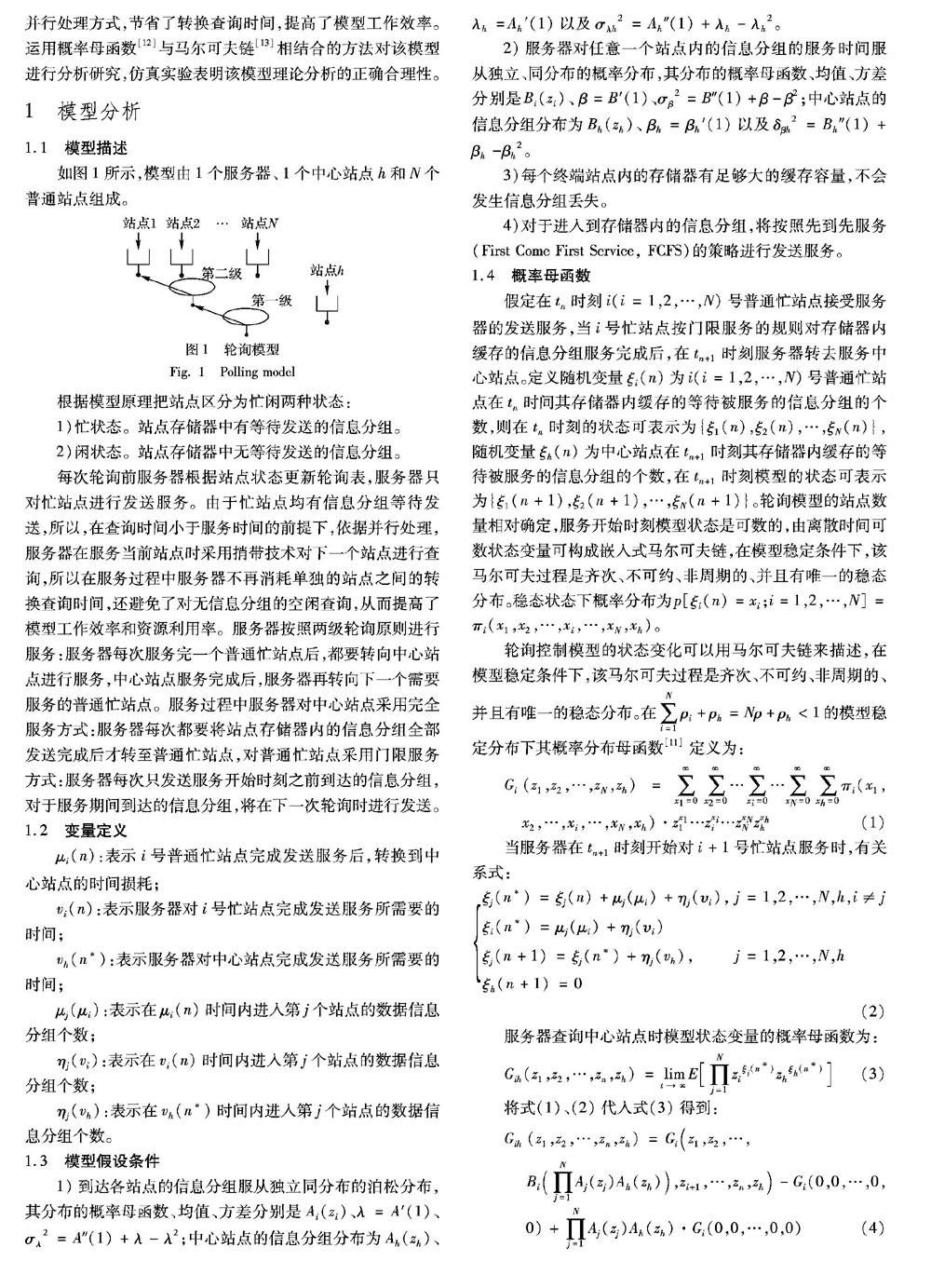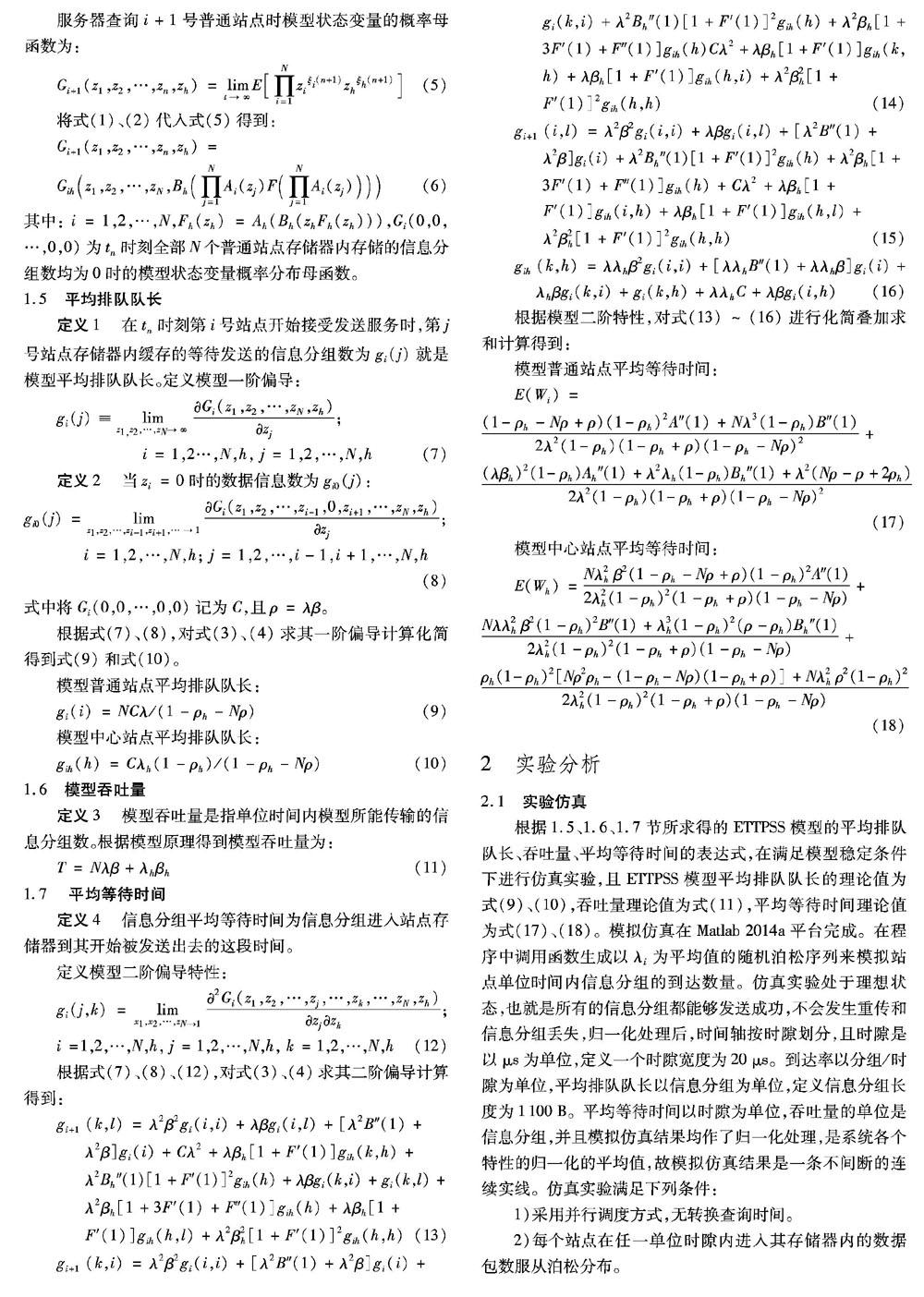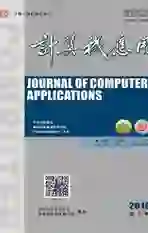区分站点状态的两级轮询控制系统
2019-08-01杨志军孙洋洋
杨志军 孙洋洋



摘 要:针对提高轮询控制模型工作效率和区分网络优先级的问题,提出了区分站点忙闲状态的完全门限两级轮询控制模型(ETTPSS)。模型以两级优先级为基础,依据站点的忙闲状态采用并行处理方式只对忙站点进行信息分组发送服务。模型既能区分传输服务优先级又能避开对无信息分组的空闲站点的查询,从而提高了模型资源利用率和工作效率。运用概率母函数与马尔可夫链相结合的方法对该模型进行理论分析研究,精确解析了模型各个重要性能参数。仿真实验结果表明,仿真值与理论值近似相等,说明理论分析正确合理。与普通轮询模型相比,该模型性能大幅度提高。
关键词:优先级;忙站点;轮询模型;利用率;工作效率
中图分类号:TN911
文献标志码:A
Abstract: To improve the work efficiency of polling control model and distinguish network priorities, an ExhaustiveThreshold Twostage Polling control model based on Site Status (ETTPSS) was proposed. Based on two levels of priority, parallel processing was used to only send information to busy sites according to busy and idle states of sites. The model could not only distinguish the priorities of transmission services but also avoid the queries to the idle sites without information packets, thereby improving model resource utilization and work efficiency. The method of probabilistic generating function and Markov chain was used to analyze the model theoretically, and the important performance parameters of the model were analyzed accurately. The simulation results show that the simulation values and the theoretical values are approximately equal, indicating that the theoretical analysis is correct and reasonable. Compared with normal polling model, the model performance is greatly improved.
英文关键词Key words: priority; busy site; polling model; utilization; work efficiency
0 引言
轮询控制模型具有服务质量保障的优点,一直是通信网络中媒体访问控制(Media Access Control, MAC)一种重要的调度方式,使其在现代网络中应用非常普遍[1]。文献[2]分析研究了轮询控制模型在大数据流式计算平台Apache Storm中的应用;文献[3-5]分析研究了轮询控制模型在计算机网络异构无线网络以及信息采集的应用。
轮询控制模型中,对无信息分组的空闲站点的查询会浪费模型资源。文献[6]通过对有信息分组发送需求的忙站点分配信道避免空闲查询,且服务器完成对当前站点的信息发送后需要经过一个转换查询时间才能对下一个需要信息发送的站点进行服务,而采用并行调度控制方式[7],就是把查询和服务过程进行并行处理,不再消耗模型的转换查询时间。不过,轮询表的生成与站点忙闲状态相互独立,特别是当站点空闲时间较长时,接收者每次轮询都要对空闲站点进行查询监听,造成模型的工作效率和资源利用率大幅度降低,并且也不能区分网络业务优先级。文献[8]構建“完全+门限”轮询服务两级模型以区分业务优先级,但是该模型查询服务包括空闲站点在内的所有站点,信道利用率受到限制。文献[9]提出区分站点状态的限定(K=2)服务方式,文献[10] 提出区分站点状态的完全服务方式。虽然文献[9-10]基于不同的轮询服务方式来区分站点的忙闲状态,以降低系统的平均等待时间和能耗来提高系统网络资源利用率,但并未设置中心站点和普通站点来区分网络业务的传输优先级。
针对上述问题,本文依据轮询模型的动态性[11],提出了区分站点忙闲状态的完全门限两级轮询控制模型(ExhaustiveThreshold Twolevel Polling control model based on Site Status, ETTPSS)。该模型算法与文献[9-10]相比,最大的创新是进行中心站点与普通站点的两级设置,中心站点传输高优先级业务,普通站点传输低优先级业务,解决了网络业务传输优先级的问题。该模型算法与文献[9-10]模型算法相同之处就是同样根据站点的忙闲状态,对有发送需求的忙站点进行信息分组的发送服务,且服务过程与查询过程采用并行处理方式,节省了转换查询时间,提高了模型工作效率。运用概率母函数[12]与马尔可夫链[13]相结合的方法对该模型进行分析研究,仿真实验表明该模型理论分析的正确合理性。
4 结语
本文提出了一种采用CNN算法进行UWB信道环境分类的方法,直接对信道统计特性进行特征提取,识别信道环境。实验结果表明, 将CNN用于信道环境分类具有较高识别率,并且模型稳定性比较高。
參考文献 (References)
[1]CERNOHORSKY J, JANDURA P, RYDLO P. Real time ultrawideband localisation [C]// ICCC 2018: Proceedings of the 2018 19th International Carpathian Control Conference. Piscataway, NJ: IEEE, 2018: 445-450.
[2]LING P, SHEN C, ZHANG K, et al. An improved NLOS error elimination algorithm for indoor ultrawideband localization [C]// Proceedings of the 2017 IEEE SENSORS. Piscataway, NJ: IEEE, 2017: 1-3.
[3]LI X, ZHANG T. Research on improved UWB localization algorithm in NLOS environment [C]// Proceedings of the 2018 International Conference on Intelligent Transportation, Big Data and Smart City. Washington, DC: IEEE Computer Society, 2018:707-711.
[4]孙希延,刘健,纪元法,等.基于似然比检验的超宽带信道检测与定位算法[J].电子与信息学报,2017,39(3):590-597.(SUN X Y, LIU J, JI Y F, et al. UWB channel detection and location algorithm based on likelihood ratio test [J]. Journal of Electronics and Information Technology, 2017,39(3): 590-597.)
[5]ALBAIDHANI A, MORELL A, VICARIO J L. Ranging in UWB using commercial radio modules: experimental validation and NLOS mitigation [C]// Proceedings of the 2016 International Conference on Indoor Positioning and Indoor Navigation. Piscataway, NJ: IEEE, 2016: 1-7.
[6]MUQAIBEL A H, LANDOLSI M A, MAHMOOD M N. Practical evaluation of NLOS/LOS parametric classification in UWB channels [C]// Proceedings of the 2013 1st International Conference on Communications, Signal Processing and their Applications. Piscataway, NJ: IEEE, 2013:1-6.
[7]张浩,梁晓林,吕婷婷,等.一种新颖的基于偏度的非视距区分算法[J].电讯技术,2015,55(5):484-490.(ZHANG H, LIANG X L, LYU T T, et al. A novel nonlineofsight identification algorithm based on skewness [J]. Telecommunication Engineering, 2015, 55(5): 484-490.)
[8]LIU M, SHI J, LI Z, et al. Towards better analysis of deep convolutional neural networks [J]. IEEE Transactions on Visualization and Computer Graphics, 2016, 23(1):91-100.
[9]李彦冬,郝宗波,雷航.卷积神经网络研究综述[J].计算机应用,2016,36(9):2508-2515.(LI Y D, HAO Z B, LEI H. Survey of convolutional neural network [J]. Journal of Computer Applications, 2016, 36(9): 2508-2515.)
[10]王勇,周慧怡,俸皓,等.基于深度卷积神经网络的网络流量分类方法[J].通信学报,2018,39(1):14-23.(WANG Y, ZHOU H Y, FENG H, et al. Network traffic classification method basing on CNN [J]. Journal on Communications, 2018, 39(1): 14-23.)
[11]YAZDANDOOST K Y. Channel modeling subcommittee report [R/OL].[2018-03-20]. Networks https://doi.org/IEEE P802.1502/490r1SG3a.
[12]WANG X. A UWB positioning scheme based on BP neural network in NLOS environment [C]// Proceedings of the 2011 7th International Conference on Wireless Communications, Networking and Mobile Computing. Piscataway, NJ: IEEE, 2011: 1-3.
[13]XIONG Z, CHEN K, GU C. An algorithm of image classification based on BP neural network [C]// Proceedings of the 2012 IEEE International Conference on Computer Science and Automation Engineering. Piscataway, NJ: IEEE, 2012: 523-526.
[14]LIU H, LIANG Z, LIU D, et al. Improved UWB indoor positioning algorithms based on BP neural network model [C]// Proceedings of the 12th International Conference on Communications and Networking in China. Berlin: Springer, 2017: 114-124.
